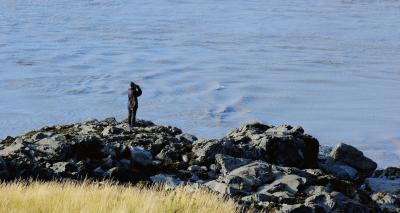On September 23, employees from BOEM's Alaska OCS Region spent a beautiful Saturday morning counting beluga whales.
Belugas are relatively small whales, typically reaching a length of 11-15 feet, with a small dorsal fin. While juvenile belugas are a dark and sometimes bluish gray in color, adult belugas are a gleaming, snow white. A beluga's bulging, squishy forehead — called, no kidding, a "melon" — gives it a comical appearance but is thought to help the beluga focus sound waves for more effective communication and echolocation.
Alaska harbors five distinct populations of belugas -- in Cook Inlet, Bristol Bay, the Bering Sea, the Eastern Chukchi and the Beaufort Sea, respectively -- and genetic data suggests that these populations do not interbreed.
The Cook Inlet population is Alaska's smallest and most genetically distinct. In the 1970s the population numbered over a thousand; today, that number has dwindled to about 330. In 2008 the Cook Inlet belugas were listed as endangered under the Endangered Species Act.
Belugas Count!, now in its fifth year, is a BOEM-sponsored, NOAA-led and citizen-driven initiative to track the population of this ecologically important species. At the forefront of the effort are the citizens who volunteer to staff 14 public shore viewing stations around the inlet.
Several BOEM employees took their stations Saturday at Windy Corner, on a branch of the inlet called Turnagain Arm southeast of Anchorage. Everyone was in place at 10 a.m., and the whales cooperated by showing up almost immediately, making their way along the shore in pursuit of salmon and the small, oil-rich fish known locally as hooligan. As the volunteers counted, they were joined by a small crowd of onlookers, including children excited to see the little whales. Over the next few hours the whale watchers counted 13 belugas passing by.
"Belugas Count! is in the best spirit of citizen-science," said Dr. Christina Bonsell, an ecologist with BOEM's Alaska Region who coordinated BOEM's involvement in this year's project. "The federal government drives the science, but we there would be no Belugas Count! without all the volunteers who turn out to actually do the counting. Everyone loves whales, and I love to see all the people who gave up their Saturday morning to help us ensure that Cook Inlet remains a home to these fascinating animals."
-- BOEM --
The Department of the Interior’s Bureau of Ocean Energy Management (BOEM) is responsible for America’s offshore energy and mineral resources. The bureau promotes energy independence, environmental protection and economic development through responsible, science-based management of energy and mineral resources on the U.S. Outer Continental Shelf.




